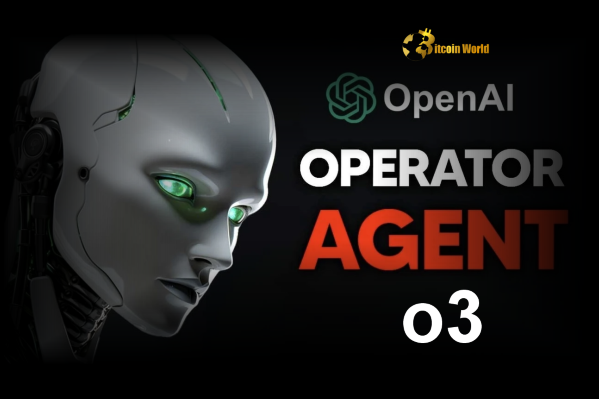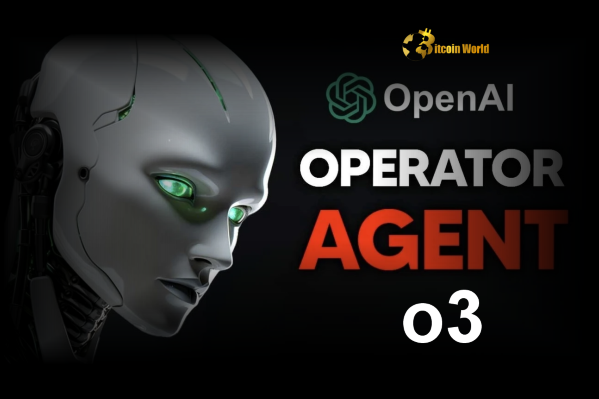BitcoinWorld

AI Agent Gets Revolutionary Upgrade: OpenAI Operator Enhanced with o3 Model
In the rapidly evolving world where artificial intelligence is becoming increasingly capable of performing tasks once thought exclusive to humans, significant upgrades to core AI systems are big news. For enthusiasts tracking the intersection of AI and technology, particularly within communities familiar with complex digital systems like those in cryptocurrency, the development of more sophisticated autonomous tools is key. OpenAI has just announced a major enhancement to one of its promising tools, the OpenAI Operator agent.
The Core Upgrade: Moving to the OpenAI o3 Model
OpenAI is making a notable change under the hood of its Operator agent. This agent is designed to function within a cloud-hosted virtual machine, capable of browsing the web and using software autonomously. Previously, Operator ran on a custom version of the GPT-4o model. The significant news is the transition to a model based on the o3 series, specifically designed for reasoning tasks.
Why the switch? According to OpenAI, the o3 series models demonstrate superior performance on various benchmarks, particularly those involving complex math and intricate reasoning. This suggests the upgraded Operator should be more adept at understanding instructions and navigating digital environments effectively.
OpenAI confirmed this in a blog post, stating, “We are replacing the existing GPT‑4o-based model for Operator with a version based on OpenAI o3.” It’s worth noting that the API version of Operator will continue to utilize the GPT-4o base for now.
The Rise of the AI Agent Landscape
This upgrade comes amidst a clear trend in the AI industry: the race to develop highly capable AI agents that can perform complex chores with minimal supervision. The goal is to create tools that can reliably execute multi-step tasks across digital platforms.
OpenAI’s Operator is not alone in this space. Other major players are also fielding their own versions of autonomous agents:
- Google: Offers a “computer use” agent via its Gemini API, capable of web browsing and actions on behalf of users. They also have a consumer-focused tool called Mariner.
- Anthropic: Their models are also gaining the ability to perform computer tasks, such as opening files and navigating webpages.
This competitive landscape is pushing innovation, with each company striving to build the most reliable and versatile AI Agent capable of complex AI Reasoning.
Enhanced Safety Measures and Capabilities of o3 Operator
The new model, dubbed o3 Operator, has undergone specific fine-tuning. OpenAI reports that it was “fine-tuned with additional safety data for computer use.” This included datasets specifically designed to teach the model OpenAI’s boundaries regarding confirmations and refusals for certain actions.
OpenAI released a technical report detailing o3 Operator’s performance on safety evaluations. The report provides insights into how the new model handles sensitive situations:
- It uses the same multi-layered approach to safety as the previous version.
- The report indicates it is less likely to refuse performing “illicit” activities compared to the GPT-4o version.
- It is also less likely to refuse searching for sensitive personal data.
- However, the report also notes it is less susceptible to prompt injection attacks, a common method used to manipulate AI behavior.
These findings highlight the ongoing challenge of balancing capability with safety in advanced Autonomous AI systems. While the model might be more robust against certain attacks, its reduced refusal rate for questionable tasks presents a new area for scrutiny and continued development.
Despite inheriting the strong coding capabilities of the base o3 model, OpenAI clarifies that o3 Operator does not have native access to a coding environment or terminal, limiting its direct code execution abilities within its operational context.
What This Means for Autonomous AI
The upgrade to the OpenAI o3 Model for Operator signifies a step forward in building more capable and potentially more reliable Autonomous AI systems. Improved AI Reasoning is crucial for agents expected to perform tasks independently across dynamic digital environments.
As these agents become more sophisticated, their potential applications grow, but so do the complexities surrounding their deployment, safety, and ethical use. The technical report’s findings underscore that developing agents capable of advanced AI Reasoning while remaining consistently safe and aligned with human intent is a continuous process with evolving challenges.
Looking Ahead: The Future of AI Agents
The competition among AI companies to build the best AI Agent is heating up. As models like OpenAI’s o3 become the foundation for these tools, we can expect to see agents capable of handling increasingly complex tasks. The focus on safety fine-tuning, as seen with o3 Operator, indicates that developers are actively trying to address the risks associated with giving AI more autonomy, though challenges remain.
The development of powerful autonomous tools is a key area to watch, impacting everything from personal productivity to enterprise automation. Keeping informed about these core model upgrades is essential for understanding the trajectory of AI capabilities.
To learn more about the latest AI Model trends, explore our article on key developments shaping AI features.
This post AI Agent Gets Revolutionary Upgrade: OpenAI Operator Enhanced with o3 Model first appeared on BitcoinWorld and is written by Editorial Team




